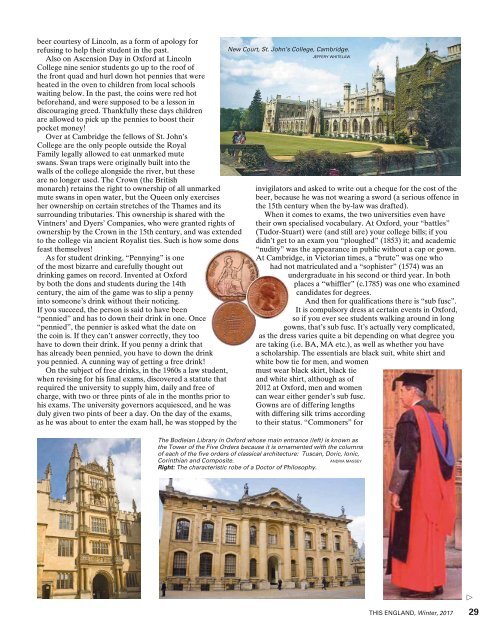This England
This England is the quarterly magazine for all who love our green and pleasant land and are unashamedly proud of their English roots. Published since 1968 the magazine has now become one of England’s best loved magazines and has a readership of over 115,000 people from around the world. As well as being popular in England it outsells all other British heritage magazines in Canada, Australia, New Zealand, South Africa and is sent to readers in every country of the world. Published in Cheltenham, in the heart of picturesque Gloucestershire, the magazine is edited, printed and despatched direct from England. Subscribe today and celebrate all that is best about England and the English way of life.
This England is the quarterly magazine for all who love our green and pleasant land and are unashamedly proud of their English roots. Published since 1968 the magazine has now become one of England’s best loved magazines and has a readership of over 115,000 people from around the world. As well as being popular in England it outsells all other British heritage magazines in Canada, Australia, New Zealand, South Africa and is sent to readers in every country of the world.
Published in Cheltenham, in the heart of picturesque Gloucestershire, the magazine is edited, printed and despatched direct from England. Subscribe today and celebrate all that is best about England and the English way of life.
You also want an ePaper? Increase the reach of your titles
YUMPU automatically turns print PDFs into web optimized ePapers that Google loves.
eer courtesy of Lincoln, as a form of apology for<br />
refusing to help their student in the past.<br />
Also on Ascension Day in Oxford at Lincoln<br />
College nine senior students go up to the roof of<br />
the front quad and hurl down hot pennies that were<br />
heated in the oven to children from local schools<br />
waiting below. In the past, the coins were red hot<br />
beforehand, and were supposed to be a lesson in<br />
discouraging greed. Thankfully these days children<br />
are allowed to pick up the pennies to boost their<br />
pocket money!<br />
Over at Cambridge the fellows of St. John’s<br />
College are the only people outside the Royal<br />
Family legally allowed to eat unmarked mute<br />
swans. Swan traps were originally built into the<br />
walls of the college alongside the river, but these<br />
are no longer used. The Crown (the British<br />
monarch) retains the right to ownership of all unmarked<br />
mute swans in open water, but the Queen only exercises<br />
her ownership on certain stretches of the Thames and its<br />
surrounding tributaries. <strong>This</strong> ownership is shared with the<br />
Vintners’ and Dyers’ Companies, who were granted rights of<br />
ownership by the Crown in the 15th century, and was extended<br />
to the college via ancient Royalist ties. Such is how some dons<br />
feast themselves!<br />
As for student drinking, “Pennying” is one<br />
of the most bizarre and carefully thought out<br />
drinking games on record. Invented at Oxford<br />
by both the dons and students during the 14th<br />
century, the aim of the game was to slip a penny<br />
into someone’s drink without their noticing.<br />
If you succeed, the person is said to have been<br />
“pennied” and has to down their drink in one. Once<br />
“pennied”, the pennier is asked what the date on<br />
the coin is. If they can’t answer correctly, they too<br />
have to down their drink. If you penny a drink that<br />
has already been pennied, you have to down the drink<br />
you pennied. A cunning way of getting a free drink!<br />
On the subject of free drinks, in the 1960s a law student,<br />
when revising for his final exams, discovered a statute that<br />
required the university to supply him, daily and free of<br />
charge, with two or three pints of ale in the months prior to<br />
his exams. The university governors acquiesced, and he was<br />
duly given two pints of beer a day. On the day of the exams,<br />
as he was about to enter the exam hall, he was stopped by the<br />
New Court, St. John’s College, Cambridge.<br />
JEFFERY WHITELAW<br />
invigilators and asked to write out a cheque for the cost of the<br />
beer, because he was not wearing a sword (a serious offence in<br />
the 15th century when the by-law was drafted).<br />
When it comes to exams, the two universities even have<br />
their own specialised vocabulary. At Oxford, your “battles”<br />
(Tudor-Stuart) were (and still are) your college bills; if you<br />
didn’t get to an exam you “ploughed” (1853) it; and academic<br />
“nudity” was the appearance in public without a cap or gown.<br />
At Cambridge, in Victorian times, a “brute” was one who<br />
had not matriculated and a “sophister” (1574) was an<br />
undergraduate in his second or third year. In both<br />
places a “whiffler” (c.1785) was one who examined<br />
candidates for degrees.<br />
And then for qualifications there is “sub fusc”.<br />
It is compulsory dress at certain events in Oxford,<br />
so if you ever see students walking around in long<br />
gowns, that’s sub fusc. It’s actually very complicated,<br />
as the dress varies quite a bit depending on what degree you<br />
are taking (i.e. BA, MA etc.), as well as whether you have<br />
a scholarship. The essentials are black suit, white shirt and<br />
white bow tie for men, and women<br />
must wear black skirt, black tie<br />
and white shirt, although as of<br />
2012 at Oxford, men and women<br />
can wear either gender’s sub fusc.<br />
Gowns are of differing lengths<br />
with differing silk trims according<br />
to their status. “Commoners” for<br />
The Bodleian Library in Oxford whose main entrance (left) is known as<br />
the Tower of the Five Orders because it is ornamented with the columns<br />
of each of the five orders of classical architecture: Tuscan, Doric, Ionic,<br />
Corinthian and Composite.<br />
ANDRIA MASSEY<br />
Right: The characteristic robe of a Doctor of Philosophy.<br />
<br />
THIS ENGLAND, Winter, 2017 2016 29
















